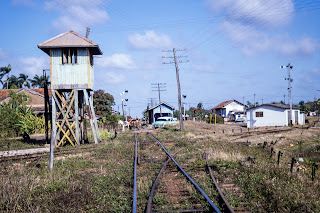Guareiras Crossing, Cuba 🇨🇺
Twenty five years ago today, having graduated university, I joined the railways as a Clerk in the Safety and Standards department of Virgin Trains in Birmingham. It doesn’t feel like a quarter of a century ago, but as they say in Trumpton, “time flies by when you’re the driver of a train”.
What full time employment did give me was money and the time to travel. Whilst we enjoyed exploring much of Western Europe during camper van holidays growing up, here was a chance to go further afield.
‘Proper’ steam, that was working for the purpose it was built, rather than preserved steam was high on my agenda having been born too late to experience this at home.
A few months after starting work, a fellow Talyllyn volunteer told me that he and a group of friends were returning to Cuba for ‘La Zafra’ sugar cane harvest in the early months of the year 2000 and did I fancy going too.
I knew very little about Cuban railways, other than it being a place where steam lingered on, a time capsule of American industrial transportation from a century before. The world economic and political situation of the sugar industry and the Russian market that kept it afloat meant that steam was hanging on by a thread and each year could be the last.
The result was a trip to Cuba being immersed in a culture and country very different to home. We started out in Havana and headed east, looking out sugar mills and their railways on our way and I will be forever grateful that I did. The year 2000 proved to be the last year that two of the biggest and favourite operations of my visit operated, the mills at Espartaco and Australia, devastated the following year by hurricanes. The bottom fell out of the sugar market and within a few years, the steam, the railways and the mills themselves lay derelict.
Recently, my friend Andy has taken the slides I took over twenty years ago and has done a superb job of scanning them in and photo editing out any blemishes and muck. The first tranche of which he sent over this week. Over the coming weeks, possibly months, as I receive them, I intend writing a series of blog posts about the different mills we visited and sharing the photos of these visits. Though I forewarn you that these blog posts will be sporadic in their appearance.
Back in 2000, information wasn’t quite on the same par as it is today via the web and social media. We were reliant on accounts from those who had been over early in the season as to which mills were running. The leader of our group had been to Cuba before and had a good idea of which mills to visit and which to avoid. Not all welcomed visitors and some had got a name for being hospitable only if dollars were exchanged. So it was a case of calling in to mills to see what was happening. Sometimes we were lucky and sometimes we weren’t. Some mills only used steam for yard shunting, or the ‘patio’ as it was called whilst others had miles of track connecting various ‘copias’, loading points with the mill. Often we would drive near the railway lines where the flat land and big skies combined with plumes of smoke from inefficient oil firing to point us in the direction of where the locomotives were. The usual operation saw trains going out at first light and returning to the mill by lunchtime. Then a second run out in the afternoon after the siesta returning at sunset or after to the mill.
Some mills I only have the odd photo or two from, whilst we made more than one visit to other mills and chased trains capturing them at various loading points on route. Over two decades on, I still know very little of the areas we visited and shall be using this process to carry out some research into what I’ve taken photos of. Information which I will share in these posts.
First up, we have a late afternoon photo showing the station and signal box on stilts at Guareiras, protecting the flat crossing of the Ferrocarriles de Cuba state railway network and the sugar lines to Reynauld Garcia and René Fraga mills. Taken after we’d visited Reynauld Garcia, the location where I saw my first Cuban steam. On the crossing, by chance are a horse drawn cart and a vintage American car. Still two of the staples of rural Cuban life at the start of this millennium. The signal box lasted a little over eighteen months after this photo was taken, destroyed by Hurricane Michelle in November 2001.



Comments
Post a Comment